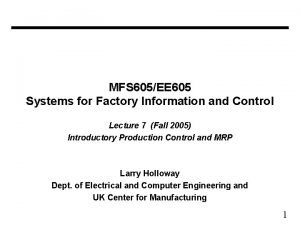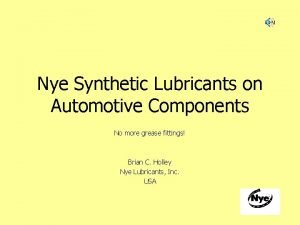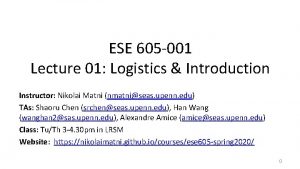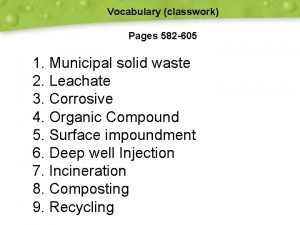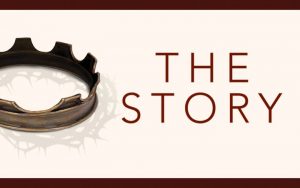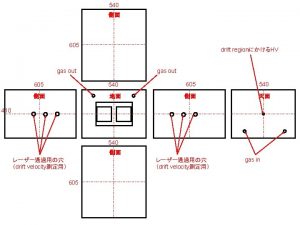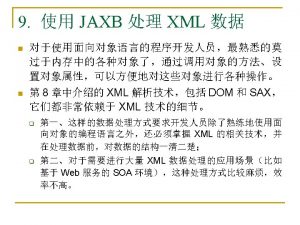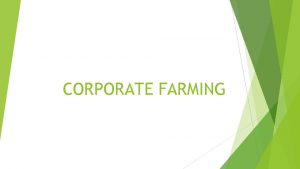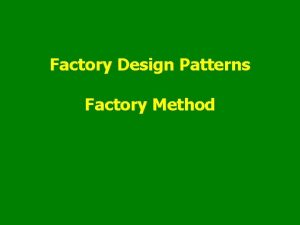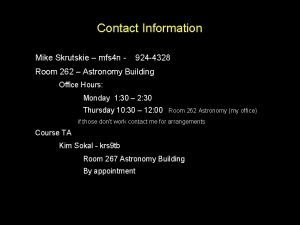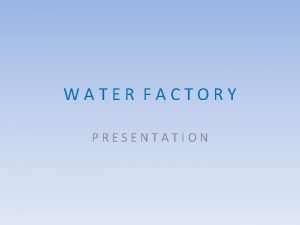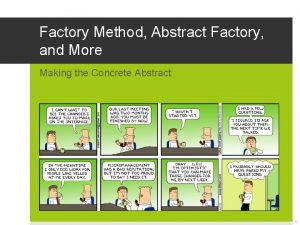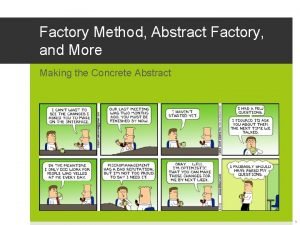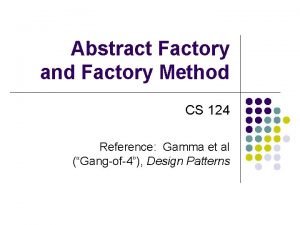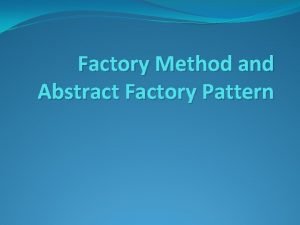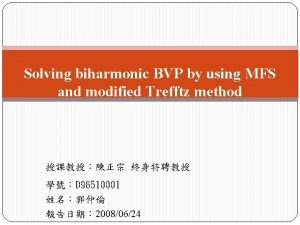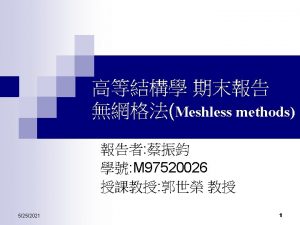MFS 605EE 605 Systems for Factory Information and

































![Fixed-Batch Policy -- Deterministic Case rfixbatch(30, 100, 0, [4, 10, 4, 10], [20, 20], Fixed-Batch Policy -- Deterministic Case rfixbatch(30, 100, 0, [4, 10, 4, 10], [20, 20],](https://slidetodoc.com/presentation_image_h/1ca6798736d5ccfec781af1ed14408dd/image-34.jpg)
![Fixed-Batch Policy -- Deterministic Case rfixbatch(30, 100, 0, [4, 10, 4, 10], [20, 20], Fixed-Batch Policy -- Deterministic Case rfixbatch(30, 100, 0, [4, 10, 4, 10], [20, 20],](https://slidetodoc.com/presentation_image_h/1ca6798736d5ccfec781af1ed14408dd/image-35.jpg)

![Fixed-batch - not ideal (30, 100, 0, [4, 10, 4, 10], [20, 20], [80, Fixed-batch - not ideal (30, 100, 0, [4, 10, 4, 10], [20, 20], [80,](https://slidetodoc.com/presentation_image_h/1ca6798736d5ccfec781af1ed14408dd/image-37.jpg)
![Fixed-batch - not ideal (30, 100, 0, [4, 10, 4, 10], [20, 20], [80, Fixed-batch - not ideal (30, 100, 0, [4, 10, 4, 10], [20, 20], [80,](https://slidetodoc.com/presentation_image_h/1ca6798736d5ccfec781af1ed14408dd/image-38.jpg)


![Fixed-Fill Policy -- Deterministic Case rfixfill(40, 100, 0, [4, 10, 4, 10], [20, 20], Fixed-Fill Policy -- Deterministic Case rfixfill(40, 100, 0, [4, 10, 4, 10], [20, 20],](https://slidetodoc.com/presentation_image_h/1ca6798736d5ccfec781af1ed14408dd/image-41.jpg)
![Fixed-Fill Policy -- Deterministic Case rfixfill(40, 100, 0, [4, 10, 4, 10], [20, 20], Fixed-Fill Policy -- Deterministic Case rfixfill(40, 100, 0, [4, 10, 4, 10], [20, 20],](https://slidetodoc.com/presentation_image_h/1ca6798736d5ccfec781af1ed14408dd/image-42.jpg)
![Fixed-fill - disturbed (40, 100, 0, [4, 10, 4, 10], [20, 20], [100, 100], Fixed-fill - disturbed (40, 100, 0, [4, 10, 4, 10], [20, 20], [100, 100],](https://slidetodoc.com/presentation_image_h/1ca6798736d5ccfec781af1ed14408dd/image-43.jpg)
![Fixed-fill - disturbed (40, 100, 0, [4, 10, 4, 10], [20, 20], [100, 100], Fixed-fill - disturbed (40, 100, 0, [4, 10, 4, 10], [20, 20], [100, 100],](https://slidetodoc.com/presentation_image_h/1ca6798736d5ccfec781af1ed14408dd/image-44.jpg)



























- Slides: 71

MFS 605/EE 605 Systems for Factory Information and Control Lecture 8: Production Control: Continued Fall 2005 Larry Holloway Dept. of Electrical Engineering and Center for Manufacturing 1

Production Control: Task of taking orders and forecasts for final product and converting them into orders for production operations and orders for raw materials. Orders Forecasts Production Control Materials Capabilities Product Shipments Impacts lead time, WIP 2

MRP Review • MRP: Materials Requirement Planning – computerized approach to translating orders for final goods into orders for operations and raw materials – Key idea: Blow up bill of materials • expand to subcomponents • factor in lead times • determine when operations and orders should be done 3

Positive aspects of MRP • Better coordination of orders for dependent demand items… – May reduce WIP by ordering component products only as needed for final product. – But… • Production Planning: Helps determine peaks and valleys • Purchasing and Finance: tells needs over the horizon. • Sales: MRP helps sales by giving estimates of lead times… – But… 4

Issues with MRP • MRP is useful for high-level planning. • Generally seen as a problem for low-level shop-floor control • Issues: – buckets are too course for shop-floor control – Lead times treated independent of demand or batch size – Inflation of lead times or safety stock-- no method to see if these are too big, no method to encourage reduction – Commonly gives large lead times and large WIP – Assumes “Transfer quantity = order quantity” 5

Transfer Quantity vs. Order Quantity • Example: 50 components in batch, 10 minutes per part. 6

Pull System • A production system driven by actual consumption and controlled by synchronized replenishment signals. • Orders for product pulled from end of line, rest of line then responds to replace removed product Supplier order Raw materials CUSTOMER Manufacturing Facility Product 7

Just-in-time manufacturing • Just-in-time manufacturing: “Lean Manufacturing” • Key Concept: Continuous improvement to eliminate waste of all forms. • Goals: – Minimum zero inventories – zero lead time – zero set up time – lot size of 1 – zero defects – total elimination of waste Is this realistic? 8

• We will just study the production control, but concept is much bigger. Affects: – transportation – supplier relations – quality – setup – employee responsibilities – …all aspects of organization… 9

• Background: – Toyota -- postwar Japan – Taichi Ohno: Chief production engineer. – Not really noticed by US until 1970’s Why so slow for West to notice or catch on? 10

JIT/Lean • JIT/Lean is holistic approach – keep tackling all parts of system • different aspects affect each other – example: lot sizing and setup time – keep striving for continuous improvement 11

Overview • Production Control: Push vs. Pull • Kanban – Tool for Pull – Tool to drive lean – Issues in using signal kanbans • Importance of Leveling 12

Example Bill of Materials for Truck Seat assemble Seat Frame Padding Cover Material weld parts Frame Parts cut and shape material Raw Stock 13

Push System • Customer orders and forecasts are fed into beginning of line Forecasts CUSTOMER Raw materials Manufacturing Facility Product 14

The Pull System A production system driven by actual consumption and controlled by synchronized replenishment signals. Tool to: • lower inventory • reduce lead-time Supplier order Raw materials CUSTOMER Manufacturing Facility Product 15

Effect on order lead times • Push system: order sequences through all stations • Pull system: order pulls only from final station (assumes WIP available) Actual lead time for push system typically long since other orders waiting in the pipeline. 16

Effect on Work-in-Process (WIP) Push system: • longer lead times mean more orders in process – example: 3 weeks of orders vs. 1 week • longer lead times encourage larger and less frequent customer orders – demand more irregular – larger batches 17

Little’s Law “Little’s Law”: WIP = Production Rate x Throughput Time or Throughput Time = WIP / Production Rate To reduce throughput time, either reduce WIP or increase production rate 18

Effect on Quality Benefits of Pull system • Each workstation is “supplier” to preceding station. • Low WIP means faster detection of problems • Low WIP has no room for poor quality – Pull requires quality Push System: Batch orders inflated as quality safety, leads to expectation and acceptance of problems 19

INVENTORY HIDES WASTE LABOR & MATERIAL IN SEA OF INVENTORY POOR WORK BALANCING NON-PRODUCTIVE MAINTENANCE POOR QUALITY PRODUCTS OUT BAD HOUSEKEEPING EXCESSIVE SETUP TIMES INSUFFICIENT COMMUNICATION ABSENTEEISM 21

How to reduce need for stock? Minimize impact of disruptions: • shorten lead time -- more responsive to demand • improve quality -- eliminate defects • preventive maintenance • reduce setup times • improve organization and communication • improve supplier reliability 22

Kanban: A production authorization and parts replenishement signal based on consumption – fixed number circulate between producer&consumer stations – tool to limit build-up of inventory – tool to supply right parts at right time – tool to drive lean manufacturing improvements: • lower inventories make wastes more apparent 23

empty kanbans parts (with kanbans) 24

Types of Kanban Systems • Withdrawal Kanbans – 1 -card and 2 -card systems • Signal Kanbans • Emergency Kanbans and others 25

Withdrawal Kanbans • Multiple cards circulating – example: each is <1/10 daily demand • Supplier processes don’t have significant setup costs • “ 2 -card system used when distance between stations: – “Production Kanbans” and “Withdrawal Kanbans” – Allows for additional delay in circulation 26

Choosing initial number of Kanbans # of kanbans = (units daily demand) x (order cycle time) x safety / lot size Safety = 1. 00 means no safety. Safety = 1. 3 means 30% safety Example: # of kanbans = 120 x (6 hrs/8 hrs) * 1. 00 / 30 = 3 # of kanbans = 120 * (6 hrs / 8 hrs) * 1. 30 / 30 =3. 9 --> 4 In practice: keep reducing kanbans as much as possible. 27

Kanban limitations • large demand fluctuations cause problems. • Real benefits only when constrained variation in product. – Toyota: kanbans on feeder lines, not for final production 29

2 -card Kanban Production cards Move cards A A A B B Warehouse A B Producing Station A A A B A Consuming Station A A 30

Signal Kanbans • Used only when supply process has large setup cost – examples: stamping, forming, molding – should continue setup reduction • Kanban signals inventory below threshold. 31

Signal Kanban System Multiple parts (k = 1, 2, …K) for one producing machine Production for part k authorized when WIP falls below rk Fixed Batch Policies: run stops after completing fixed number of parts. Fixed Fill Policies: run stops when fixed level reached Parts produced Producing Machine Signal Kanbans Fill level fk Signal level rk Inventory for part k Parts consumed Consuming Process 32

Buffer levels for two parts buffer levels r t Time from signal to production includes kanban queue time and setup time dk Issue: In practice, sometimes kanban waits in queue too long, resulting in parts shortages. 33

Comparison of Fixed-batch and Fixed-fill • Investigations of each for: – deterministic case – variation in demand – disruptions in production – imbalance in batch-size/fill-size among parts Simulations with Matlab for two-part systems for both policies. 34

Fixed-Batch Policy: production run continues until given number of parts produced in run. rfixbatch(x 0, y 0, d 0, [rx, sx, ry, sy], [trigx, trigy], [batchx, batchy], [rangex, rangey], [probfreq, probeffect], xsetup, n) x 0, y 0 d 0 rx, ry sx, sy [rangex, rangey] [probfreq, probeffect] trigx, trigy batchx, batchy xsetup n initial inventory of product x and product y initial state: idle (d 0 = 0), producing x (d 0 = 1), or y (d 0=2). nominal consumption rates nominal production rates range of variation in demand (+/- %) frequency and effect of random drops in production. signal level batch sizes relative setup time steps of simulation 35
![FixedBatch Policy Deterministic Case rfixbatch30 100 0 4 10 4 10 20 20 Fixed-Batch Policy -- Deterministic Case rfixbatch(30, 100, 0, [4, 10, 4, 10], [20, 20],](https://slidetodoc.com/presentation_image_h/1ca6798736d5ccfec781af1ed14408dd/image-34.jpg)
Fixed-Batch Policy -- Deterministic Case rfixbatch(30, 100, 0, [4, 10, 4, 10], [20, 20], [80, 80], [1, 1], [0, 0], 100) Shows repeated cycle: (no production)/(produce x)/(no production)/(produce y) Periodic behavior with no parts shortages. 36
![FixedBatch Policy Deterministic Case rfixbatch30 100 0 4 10 4 10 20 20 Fixed-Batch Policy -- Deterministic Case rfixbatch(30, 100, 0, [4, 10, 4, 10], [20, 20],](https://slidetodoc.com/presentation_image_h/1ca6798736d5ccfec781af1ed14408dd/image-35.jpg)
Fixed-Batch Policy -- Deterministic Case rfixbatch(30, 100, 0, [4, 10, 4, 10], [20, 20], [80, 80], [1, 1], [0, 0], 100) Shows repeated cycle: (no production)/(produce x)/(no production)/(produce y) Periodic behavior with no parts shortages. 37

38
![Fixedbatch not ideal 30 100 0 4 10 4 10 20 20 80 Fixed-batch - not ideal (30, 100, 0, [4, 10, 4, 10], [20, 20], [80,](https://slidetodoc.com/presentation_image_h/1ca6798736d5ccfec781af1ed14408dd/image-37.jpg)
Fixed-batch - not ideal (30, 100, 0, [4, 10, 4, 10], [20, 20], [80, 80], [1, 1], [3, 10], 100) Occasional disruptions in production: inventories cycle down (30, 100, 0, [4, 10, 3. 8, 10], [20, 20], [80, 80], [1, 1], [0, 0], 10, 50) Mismatched demand parameters: inventories cycle down (long periodicity) 39
![Fixedbatch not ideal 30 100 0 4 10 4 10 20 20 80 Fixed-batch - not ideal (30, 100, 0, [4, 10, 4, 10], [20, 20], [80,](https://slidetodoc.com/presentation_image_h/1ca6798736d5ccfec781af1ed14408dd/image-38.jpg)
Fixed-batch - not ideal (30, 100, 0, [4, 10, 4, 10], [20, 20], [80, 80], [1, 1], [3, 10], 100) Occasional disruptions in production: inventories cycle down (30, 100, 0, [4, 10, 3. 8, 10], [20, 20], [80, 80], [1, 1], [0, 0], 10, 50) Mismatched demand parameters: inventories cycle down (long periodicity) 40

Fixed-batch: Long term periodicity Inventories spiral down until both signals present, then spiral up 41

Fixed-Fill Fixed-Batch Policy: production run continues until inventory reaches specified level rfixfill(x 0, y 0, d 0, [rx, sx, ry, sy], [trigx, trigy], [fullx, fully], [rangex, rangey], [probfreq, probeffect], xsetup, n) x 0, y 0 d 0 rx, ry sx, sy [rangex, rangey] [probfreq, probeffect] fullx, fully batchx, batchy xsetup n initial inventory of product x and product y initial state: idle (d 0 = 0), producing x (d 0 = 1), or y (d 0=2). nominal consumption rates nominal production rates range of variation in demand (+/- %) frequency and effect of random drops in production. signal level batch sizes relative setup time steps of simulation 42
![FixedFill Policy Deterministic Case rfixfill40 100 0 4 10 4 10 20 20 Fixed-Fill Policy -- Deterministic Case rfixfill(40, 100, 0, [4, 10, 4, 10], [20, 20],](https://slidetodoc.com/presentation_image_h/1ca6798736d5ccfec781af1ed14408dd/image-41.jpg)
Fixed-Fill Policy -- Deterministic Case rfixfill(40, 100, 0, [4, 10, 4, 10], [20, 20], [100, 100], [1, 1], [0, 0], 100) Repeated cycle: (noproduction)/(produce x)/(noproduction)/(produce y) Periodic behavior with no parts shortages. Initial conditions don’t matter 43
![FixedFill Policy Deterministic Case rfixfill40 100 0 4 10 4 10 20 20 Fixed-Fill Policy -- Deterministic Case rfixfill(40, 100, 0, [4, 10, 4, 10], [20, 20],](https://slidetodoc.com/presentation_image_h/1ca6798736d5ccfec781af1ed14408dd/image-42.jpg)
Fixed-Fill Policy -- Deterministic Case rfixfill(40, 100, 0, [4, 10, 4, 10], [20, 20], [100, 100], [1, 1], [0, 0], 100) Repeated cycle: (noproduction)/(produce x)/(noproduction)/(produce y) Periodic behavior with no parts shortages. Initial conditions don’t matter 44
![Fixedfill disturbed 40 100 0 4 10 4 10 20 20 100 100 Fixed-fill - disturbed (40, 100, 0, [4, 10, 4, 10], [20, 20], [100, 100],](https://slidetodoc.com/presentation_image_h/1ca6798736d5ccfec781af1ed14408dd/image-43.jpg)
Fixed-fill - disturbed (40, 100, 0, [4, 10, 4, 10], [20, 20], [100, 100], [1, 1], [3, 10], 100) (30, 100, 0, [4, 10, 3. 5, 10], [20, 20], [100, 100], [1, 1], [0, 0], 10, 50) Occasional disruptions in production: Inventories return to regular cycle. Mismatched demand parameters: Inventories find new cycle and stabilize. 45
![Fixedfill disturbed 40 100 0 4 10 4 10 20 20 100 100 Fixed-fill - disturbed (40, 100, 0, [4, 10, 4, 10], [20, 20], [100, 100],](https://slidetodoc.com/presentation_image_h/1ca6798736d5ccfec781af1ed14408dd/image-44.jpg)
Fixed-fill - disturbed (40, 100, 0, [4, 10, 4, 10], [20, 20], [100, 100], [1, 1], [3, 10], 100) (30, 100, 0, [4, 10, 3. 5, 10], [20, 20], [100, 100], [1, 1], [0, 0], 10, 50) Occasional disruptions in production: Inventories return to regular cycle. Mismatched demand parameters: Inventories find new cycle and stabilize. 46

Signal Kanban Summary • Simulation of policies under two-part system. • Poorly configured or disrupted fixed-batch policy has longperiod behavior which slowly cycles down inventory levels. – problem: continuous improvement activities for reducing threshold at begining of long-period may lead to subsequent parts shortages • Fixed-fill is robust to configuration and disruptions. – requires real-time buffer level info during fill – consistency of behavior allows much lower thresholds 47

Other Kanban signals • Requests for die setup • Requests for die change • Requests for maintenance • etc. 48

Kanban Limitations • Large demand fluctuations cause problems – Will there be enough cards in system to keep it running and responsive? – Kanban quantities or sizes adjusted • Real benefits only when limited variation: – Limited variety: • Toyota: kanbans on feeder lines -- not final product. – Limited fluctuations: • Demand leveling – Limited disruptions • Preventive maintenance, setup reduction, problem-solving workforce 49

Preconditions to using Kanbans Implement: – focused factory and cellular production – visual management and standardized work – kaizen and problem solving – setup reductions – demand leveling 50

Kanban on Feeder Lines Final Assembly -- wide variety Feeder lines -- limited variety 51

Leveling • Leveling: smooth production – Spread production of each product over periods – Smoother production at supplying stations – Allows response to late-period changes A B A A A B A B B B 52

Importance of Leveling • Leveling: even consumption of parts – by month, by week, by hour – coordination of sales, marketing, production – some finished goods inventory • Critical for success of Kanban system – no excess inventory to handle significant swings in consumption – kanban quantities depend on replenishment period 53

Pull/Kanban Summary • Kanban is implementation of Pull system • Simplified production control / visual tool – Reduced lead time – Reduced WIP • Improved Communication – faster recognition of problems – faster response to changes in demand • Improved operator responsibility (Quality) • Limitations: Requires limits on disruptions and variations. • Can be tool to expose problems and focus on continuous improvement. 54

• OPT and review of production control… 55

Review • Push system (MRP) – designed for scheduling individual order/forecast batches – Good: helps explode requirements for end items into timephased orders for components and raw materials – Bad: • typically associated with large WIP, long lead times • buckets too course for low-level floor control 56

Review • Pull system (Kanban, just-in-time) – part of larger philosophy of lean manufacturing – Allows tight control of WIP – production is keyed to consumption (pulled from end of line) – Good: • can be used as tool for reducing WIP and Leadtime and identification of problems needing improvement --> tool for assisting and achieving continuous improvement • responsive to demand • less reliance on forecasts – Drawbacks: • assumes leveling • assumes limited variety of products on the kanban line 57

• What if we don’t have level demand or constrainted variety of parts for kanban? – Use kanban on feeder lines (example: Toyota) – Use kanban on restricted sets of products • focused factory within factory • cellular manufacturing 58

OPT • OPT: “Optimized Production Technology” – philosophy (and software) aimed between MRP and Kanban – Developed by Eliyahu Goldrat – Popularized through a novel called “The Goal” • philosophy taught through a story – Many good points in philosophy - • points are adopted and used even when software is not – Also goes by: • Theory of constraints • Drum-Buffer-Rope (DBR) 59

• The goal of the firm: To make money • How to measure the goal: – net profit per product – return on investment – cash flow • Measures on the plant floor that drive the global measurements: – Throughput (DBR: rate for selling finished products) – Inventory – Operating Expense 60

• Increase throughput: – profit per good up – ROI up – cashflow up • Reduction in operating expenses: – profit per good up – ROI up – cash flow up • Reduction in inventory: reduces operating expenses : – ROI up – cashflow up – profit per good unchanged – also: improves responsiveness, quality, price: • more competitive 61

• DBR philosophy tells how to manage throughput, operating expense, and inventory to move toward goals: • Philosophy summarized in 9 (sometimes 10) “rules of OPT” – underlying theme: manage your constraints (bottlenecks) • use them to dictate your schedule and your activities 62

• Rule 1: balance flow, not capacity: • Key idea: we shouldn’t worry about capacity, as long as we have enough. – Instead, we should schedule our line to maintain flow of product, regardless of how much capacity is being used 63

• Rule 2: “Level of utilization of a non-bottleneck is determined not by its own potential, but by other constraints in the system” • All parts of mfg. System are either a bottleneck or a nonbottleneck – bottleneck: a point or storage in process that limits the amount of product that a factory can produce • Example: 64

• Types of bottleneck relationships 65

• Rule 3: Utilization and activation of a resource are not synonomous. Doing work regardless of whether it is needed: keeping machines busy vs. Doing required work only “Don’t confuse being busy with being productive” Being busy can lead to inventory buildup which cannot be absorbed by bottleneck or market share 66

• Rule 4: An hour lost at a bottleneck is an hour lost for the total system • Thus: strive to use bottlenecks at 100% – implication: • an hour gained at a bottleneck means ganins throughout system • This focuses setup reduction on bottlenecks • Also encourages large lots on bottlenecks 67

• Rule 4: An hour saved at a non-bottleneck is a mirage • saving that time may be just increasing idle time • Thus: can use small lot sizes on NB 68

• Rule 6: Bottlenecks govern both throughput and inventory in the system • Bottlenecks constrain throughput, but also: – stocks buildup to keep bottlenecks busy – lot sizes large at bottlenecks to reduce setup impact 69

• Rule 7: The transfer batch may not and often should not be equal to the process batch • Rule 8: Process batch size should be variable, not fixed – dynamically determine lot size for each operation 70

• Rule 9: Lead times should be variable and not fixed. • Rule : Consider all constraints when establishing schedules • Rule: Sum of local optima is not global optimum. 71

Drum-Buffer-Rope Approach • Combine push and pull. • The bottleneck becomes the drum which drives the system rate • The following stations are operated in push mode: – Orders are released from the bottleneck and pushed (flow) at their own speed in the system • The preceding stations are operated in a pull mode: – There is a “rope” tying the entry operation to the bottleneck – thus allowing new parts to enter only as the bottleneck releases others. 72

Drum-Buffer-Rope (DBR/TOC) examples 73
 Claire scharwatt
Claire scharwatt Mfs sakha
Mfs sakha Fuzzy expert system example
Fuzzy expert system example Mrp ou mfs
Mrp ou mfs Java factory factory joke
Java factory factory joke Uniflor 8951
Uniflor 8951 Ese605
Ese605 Mh 605
Mh 605 Recycling of solid waste
Recycling of solid waste Deams outreach portal
Deams outreach portal 9.605/1998
9.605/1998 Recapcs
Recapcs Is 605
Is 605 What happened in 605 bc
What happened in 605 bc Kontinuitetshantering
Kontinuitetshantering Typiska novell drag
Typiska novell drag Nationell inriktning för artificiell intelligens
Nationell inriktning för artificiell intelligens Vad står k.r.å.k.a.n för
Vad står k.r.å.k.a.n för Shingelfrisyren
Shingelfrisyren En lathund för arbete med kontinuitetshantering
En lathund för arbete med kontinuitetshantering Kassaregister ideell förening
Kassaregister ideell förening Tidbok yrkesförare
Tidbok yrkesförare A gastrica
A gastrica Densitet vatten
Densitet vatten Datorkunskap för nybörjare
Datorkunskap för nybörjare Boverket ka
Boverket ka Tes debattartikel
Tes debattartikel För och nackdelar med firo
För och nackdelar med firo Nyckelkompetenser för livslångt lärande
Nyckelkompetenser för livslångt lärande Påbyggnader för flakfordon
Påbyggnader för flakfordon Formel för lufttryck
Formel för lufttryck Offentlig förvaltning
Offentlig förvaltning Jag har nigit för nymånens skära text
Jag har nigit för nymånens skära text Presentera för publik crossboss
Presentera för publik crossboss Jiddisch
Jiddisch Plats för toran ark
Plats för toran ark Treserva lathund
Treserva lathund Luftstrupen för medicinare
Luftstrupen för medicinare Claes martinsson
Claes martinsson Centrum för kunskap och säkerhet
Centrum för kunskap och säkerhet Programskede byggprocessen
Programskede byggprocessen Mat för unga idrottare
Mat för unga idrottare Verktyg för automatisering av utbetalningar
Verktyg för automatisering av utbetalningar Rutin för avvikelsehantering
Rutin för avvikelsehantering Smärtskolan kunskap för livet
Smärtskolan kunskap för livet Ministerstyre för och nackdelar
Ministerstyre för och nackdelar Tack för att ni har lyssnat
Tack för att ni har lyssnat Referat mall
Referat mall Redogör för vad psykologi är
Redogör för vad psykologi är Stål för stötfångarsystem
Stål för stötfångarsystem Tack för att ni har lyssnat
Tack för att ni har lyssnat Borra hål för knoppar
Borra hål för knoppar Orubbliga rättigheter
Orubbliga rättigheter Formula varians
Formula varians Tack för att ni har lyssnat
Tack för att ni har lyssnat Steg för steg rita
Steg för steg rita Verksamhetsanalys exempel
Verksamhetsanalys exempel Tobinskatten för och nackdelar
Tobinskatten för och nackdelar Blomman för dagen drog
Blomman för dagen drog Datumr
Datumr Egg för emanuel
Egg för emanuel Elektronik för barn
Elektronik för barn Plagg i rom
Plagg i rom Strategi för svensk viltförvaltning
Strategi för svensk viltförvaltning Kung som dog 1611
Kung som dog 1611 Ellika andolf
Ellika andolf Sju för caesar
Sju för caesar Tack för att ni lyssnade
Tack för att ni lyssnade Tallinjen
Tallinjen Rimma meningar
Rimma meningar Inköpsprocessen steg för steg
Inköpsprocessen steg för steg Fuktmätningar i betong enlig rbk
Fuktmätningar i betong enlig rbk



